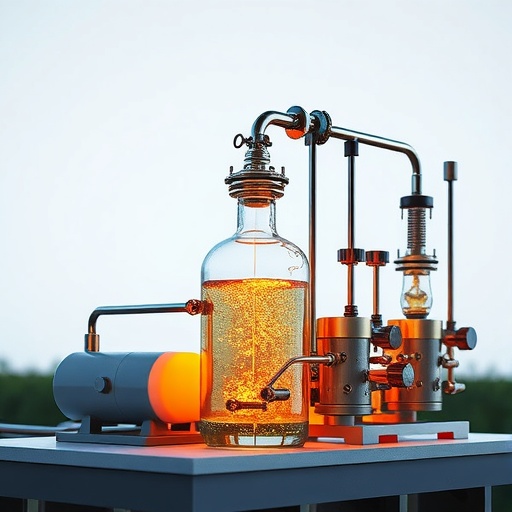A groundbreaking advancement in sustainable chemistry could soon revolutionize the way methanol is produced from biomass, bringing the process closer to decentralization and economic viability. Researchers at Friedrich-Alexander-Universität Erlangen-Nürnberg (FAU) have unveiled a novel method that allows raw and waste biomass materials to be converted into methanol through a self-contained procedure operating under mild reaction conditions. This innovation addresses long-standing inefficiencies associated with traditional biomass gasification techniques, potentially eliminating the need for complex drying and costly transportation of biomass to large, centralized processing plants.
Methanol, chemically known as CH₃OH, is a highly versatile compound widely utilized as a basic chemical feedstock and an emerging energy carrier. Its ability to serve as a “drop-in” fuel compatible with current internal combustion engines positions methanol as a promising player in the transition from fossil fuels to renewable energy sources. Historically, methanol production has relied heavily on natural gas, a fossil resource whose extraction and use conflict with global efforts to reduce carbon emissions. While the concept of producing methanol from biomass has been explored, existing methodologies have often suffered from high energy demands and operational complexity that have limited their scalability and sustainability.
Traditional approaches to biomass-to-methanol conversion revolve around biomass gasification. Agricultural and forestry residues, along with industrial waste streams such as paper hydrolysates, must undergo meticulous preparation steps—drying, grinding, and pelletizing—to increase energy density and facilitate transportation. These prepared feeds are then processed in large-scale gasification plants that operate at extreme temperatures reaching 1000 degrees Celsius and under high pressures ranging from 50 to 100 bar. Although effective, this sequence demands significant energy input and capital expenditure, precluding small-scale or distributed applications.
In stark contrast, the newly developed method offers a significant leap forward in carbon efficiency and process simplification. Notably, it permits the use of wet biomass sources directly, including materials like pomace, grass clippings, wood chips, and straw, without necessitating prior drying or extensive mechanical processing. The elimination of pre-treatment steps such as shredding and pelleting drastically reduces both energy consumption and operational complexity. Additionally, this innovation enables smaller, decentralized methanol production units that can be feasibly operated on-site, closer to biomass sources, thus minimizing transportation logistics and associated emissions.
A key technical hallmark of this process is its ability to sustain methanol production under mild reaction conditions, which not only reduces energy requirements but also enhances system stability and longevity. The researchers report an impressively high carbon efficiency of approximately 80 percent, underscoring the method’s potential to capitalize on biomass carbon content effectively. This level of efficiency is instrumental in advancing the viability of methanol as a green fuel and chemical intermediate, particularly under decentralized operational models suitable for farms, forestry businesses, and agricultural cooperatives.
Central to this innovative approach is the integration of green hydrogen production directly into the methanol synthesis pathway. The team designed the system to incorporate an electrolyzer that produces the hydrogen and oxygen necessary for the reaction via water electrolysis. While electrolysis is well-known for its substantial electricity consumption, pairing this process with sustainable power sources such as photovoltaic (PV) systems or local wind farms aligns well with renewable energy paradigms. The increasing practice of agrivoltaics—simultaneous use of land for agriculture and solar energy generation—could further augment the economic attractiveness of on-site methanol production by ensuring a synergetic energy supply.
The researchers also highlight the potential of dynamic operation strategies that exploit fluctuating electricity prices and availability. For instance, by temporarily storing intermediate compounds such as formic acid, the production process could be modulated to maximize methanol synthesis during periods of low-cost renewable electricity. This flexibility addresses one of the central challenges in integrating intermittent renewable energy sources into chemical manufacturing, enhancing both process economics and grid stability.
From an economic perspective, preliminary calculations indicate that methanol synthesized through this new biomass-based method could compete favorably with methanol derived from natural gas. This cost-competitiveness is a critical attribute for widespread adoption, suggesting that the technology could meaningfully contribute to industrial decarbonization without imposing prohibitive financial burdens. Such advancements are crucial given the global imperative to shift industrial processes toward carbon neutrality while maintaining supply chain resilience.
Collaboration between the FAU research team and the specialized company OxFA GmbH, renowned for its expertise in producing formic acid from biomass, has proven invaluable in advancing this concept. Their joint efforts integrate deep chemical engineering know-how and practical biomass processing capabilities, laying a solid foundation for the technology’s further development and potential commercialization.
The implications of this work extend beyond mere methanol production. By enabling decentralized, mild-condition conversion of raw biomass, this process could catalyze a paradigm shift in how renewable chemicals and fuels are generated, moving away from centralized megaplants toward more flexible, localized systems. This decentralization aligns with broader trends in sustainable manufacturing and could empower rural economies by adding value directly at the biomass source.
Furthermore, the method’s compatibility with various types of wet biomass—often abundant and underutilized residues from agricultural or forestry activities—presents a valuable opportunity to convert waste streams into high-value chemicals and fuels. This integration fosters circular bioeconomy principles, reducing waste while producing useful energy carriers, and mitigating environmental impacts associated with biomass disposal.
Finally, the publication of these findings in the prestigious journal Green Chemistry signifies the scientific community’s recognition of the method’s potential impact. Ongoing research and pilot-scale demonstrations will be critical to validating performance metrics, optimizing process parameters, and scaling the technology to operational levels that can meet market demands. Should these efforts succeed, sustainable, mild, and competitive methanol production from biomass could soon become a tangible reality, propelling the globe toward a cleaner, greener future.
Subject of Research: Sustainable methanol production from biomass using mild reaction conditions and integrated green hydrogen electrolysis.
Article Title: Methanol production in a sustainable, mild and competitive process: concept launch and analysis
News Publication Date: 10-Jul-2025
Web References:
DOI: 10.1039/D5GC01307K
Keywords
Sustainable methanol, biomass conversion, decentralized production, green hydrogen, electrolysis, carbon efficiency, mild reaction conditions, formic acid, renewable energy, agrivoltaics, bioeconomy, chemical engineering




